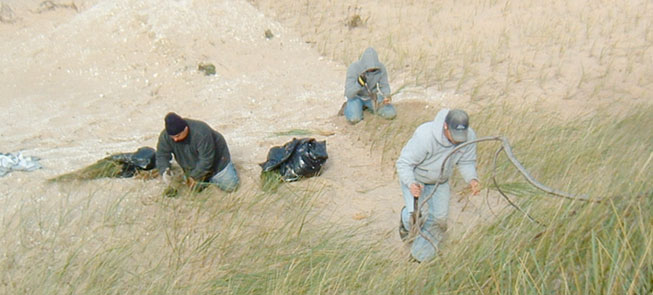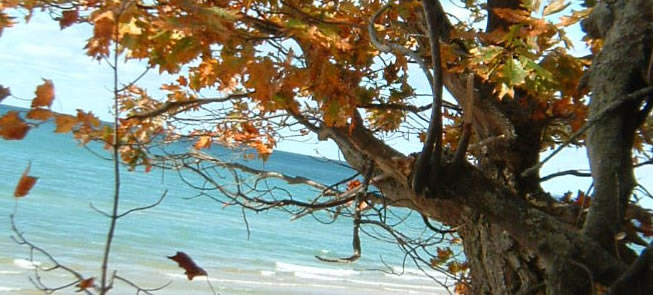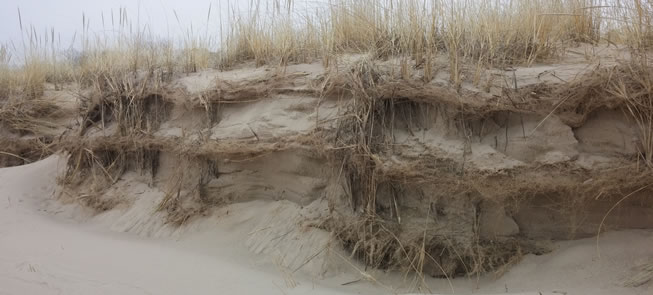One of the most impressive birds of the Lake Michigan woods is the pileated woodpecker, known commonly as the “log cock”. If you ever see one, you will not forget it. It is the size of a small crow with a black body, broad white lines on both sides of its head and under its wings with a bright red pointed crown on its head. It has a very unique undulating flight pattern so that the white under the wings flash when they stretch out.
When in the woods you may only hear its call, which sounds like a wild laugh, or its incredibly loud hammering of trees with its bill in search of food. Recently, I watched two males in courtship competition for a female. They were so busy they never knew I was there. Chasing each other from tree to tree the flashes of color were awe inspiring.
They hammer out a new nest into a dead tree every year. It is ten to twenty four inches deep with a rectangular entrance. The cavities are so large that they sometimes weaken the tree so that it breaks off in the wind. Because they need the largest and tallest tree in the forest lightning often strikes their home in thunderstorms. They usually lay four white eggs in the nest. Once they abandon their nest it becomes home to many other forest creatures such as owls, squirrels, opossums and raccoons.
They feed primarily on carpenter ants that live in dead and fallen timber. Their large gray bill pounds out fist sized chunks of dead wood through which they are able to reach the ants with their sticky tongue.
Unlike its nearly extinct cousin, the ivory billed woodpecker they are highly adaptable. Perhaps you read all the excitement about the alledged spotting of an “ivory” in a southern swamp. Loss of proper habitat led many to believe they were extinct. The “log cock” on the other hand has moved from old growth forests into younger forests near civilization. Though still rarely seen, it is making a rapid comeback from its past low population. Its numbers were decimated by hunters who sold the colorful feathers.
Each nesting pair requires six to nine hundred acres of dense woods. If you once have them living nearby you will hear them all year long because they are very territorial and do not migrate.
I read a fascinating account written in the eighteenth century of one mans attempt to raise these birds in a cage. Though he had successfully kept many other “wild” species of birds he found the pileated woodpecker to be impossible. The young birds were filthy and destroyed nearly every wooden cage he put them into with their constant hammering. Frustrated he concluded that they were untameable and finally let
them go.
I am amazed at the handiwork of the Creator in fashioning a bird with the ability to splinter wood with its beak over and over again without harming itself. God fashioned the woodpeckers bill, skull and muscles to be able to withstand the constant pounding. I get a headache just thinking about it. In seeking its food it speeds the breakdown of dead trees and makes homes for other creatures. In his wildest imagination man could not have thought of such an amazing creature.
This incredible bird is so striking that another nickname speaks of its testimony to its Creator. It is also known as the “Lord God Bird”. I believe that name is the surprised expression of the explorers and settlers when they first saw the pileated woodpecker swoop past them in the woods. They said “Lord God look at that beautiful bird!” It is as if God forced the acknowlegement of His great creative power from the lips of man.
May we never take God’s creative power for granted. This bird is an amazing testimony of His handiwork. Its loud hammering declares His great power and providential care of His creatures. Try as he might man cannot deny the earth’s testimony of the great Creator God. Great is our God and greatly to be praised.
Lord God
Man can only wonder
At the works of His hand.
Earths creatures further
The grandness of His plan.
The heaven’s birds soaring.
The sea’s myriad life.
The jungle’s life roaring.
The forest’s creatures rife.
Man can only wonder
At God Who is so great.
Whose creatures we ponder,
Field and forest and lake.
Greatest of all wonders,
Is that He loved us so,
He died for poor sinners.
That we His love might know.
Deane Wassink, April, 2006





